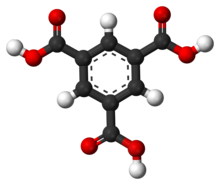트라이메스산

| |

| |
| 이름 | |
|---|---|
| 우선명 (PIN)
benzene-1,3,5-tricarboxylic acid | |
| 식별자 | |
3D 모델 (JSmol)
|
|
| 2053080 | |
| ChEBI | |
| ChEMBL | |
| ChemSpider | |
| DrugBank | |
| ECHA InfoCard | 100.008.253 |
| EC 번호 |
|
| 51147 | |
PubChem CID
|
|
| UNII | |
CompTox Dashboard (EPA)
|
|
| |
| |
| 성질 | |
| C9H6O6 | |
| 몰 질량 | 210.14034 |
| 산성도 (pKa) | 3.12, 3.89, 4.70[1] |
| 위험[2] | |
| 물질 안전 보건 자료 | Oxford MSDS |
| GHS 그림문자 | 
|
| 신호어 | 경고 |
| H315, H319, H335 | |
| P261, P264, P271, P280, P302+352, P304+340, P305+351+338, P312, P321, P332+313, P337+313, P362, P403+233, P405, P501 | |
달리 명시된 경우를 제외하면, 표준상태(25 °C [77 °F], 100 kPa)에서 물질의 정보가 제공됨.
| |
트라이메스산(영어: trimesic acid) 또는 1,3,5-벤젠트라이카복실산(영어: 1,3,5-benzenetricarboxylic acid)은 분자식이 C6H3(CO2H)3인 유기 화합물이다. 벤젠트라이카복실산의 다른 이성질체들과 마찬가지로 트라이메스산은 무색의 고체이다.[3] 트라이메스산은 일부 가소제의 전구체로서 상업적 가치가 있다.[4]
트라이메스산은 4-피리돈과 결합하여 95 °C까지 안정한 수성 젤을 만들 수 있다.[5]
트라이메스산은 넓은 1차원 빈 채널을 갖는 수소 결합 수화물 네트워크의 물로부터 결정화된다.[6]
같이 보기[편집]
각주[편집]
- ↑ Brown, H.C.; McDaniel, D.H.; Häfliger, O. (1955). 〈Chapter 14—Dissociation Constants〉. Braude, E.A.; Nachod, F.C. 《Determination of Organic Structures by Physical Methods》. New York: Academic Press. doi:10.1016/B978-1-4832-3166-2.50018-4.
- ↑ “1,3,5-Benzenetricarboxylic acid”. 《pubchem.ncbi.nlm.nih.gov》 (영어).
- ↑ Marković, Zoran; Badjuk, Dalibor; Gutman, Ivan (2004). “Geometry and Conformations of Benzenecarboxylic Acids”. 《J. Serb. Chem. Soc.》 69 (11): 877–882. doi:10.2298/JSC0411877M.
- ↑ Röhrscheid, Freimund (2000), 〈Carboxylic Acids, Aromatic〉, 《울만 공업화학 백과사전(Ullmann's Encyclopedia of Industrial Chemistry)》, Weinheim: Wiley-VCH, doi:10.1002/14356007.a05_249
- ↑ Tang, Li Ming; Wang, Yu Jiang (2009). “Highly Stable Supramolecular Hydrogels Formed from 1,3,5-Benzenetricarboxylic Acid and Hydroxyl Pyridines”. 《Chinese Chemical Letters》 20 (10): 1259–1262. doi:10.1016/j.cclet.2009.04.030.
- ↑ Herbstein, Frank H. (1987). 〈Structural Parsimony and Structural Variety Among Inclusion Complexes (with Particular Reference to the Inclusion Compounds of Trimesic acid, N-(p-tolyl)-tetrachlorophthalimide, and the Heilbron "Complexes")〉. 《Top. Curr. Chem.》. Topics in Current Chemistry 140. 107–139쪽. doi:10.1007/bfb0003838. ISBN 3-540-17307-2.
